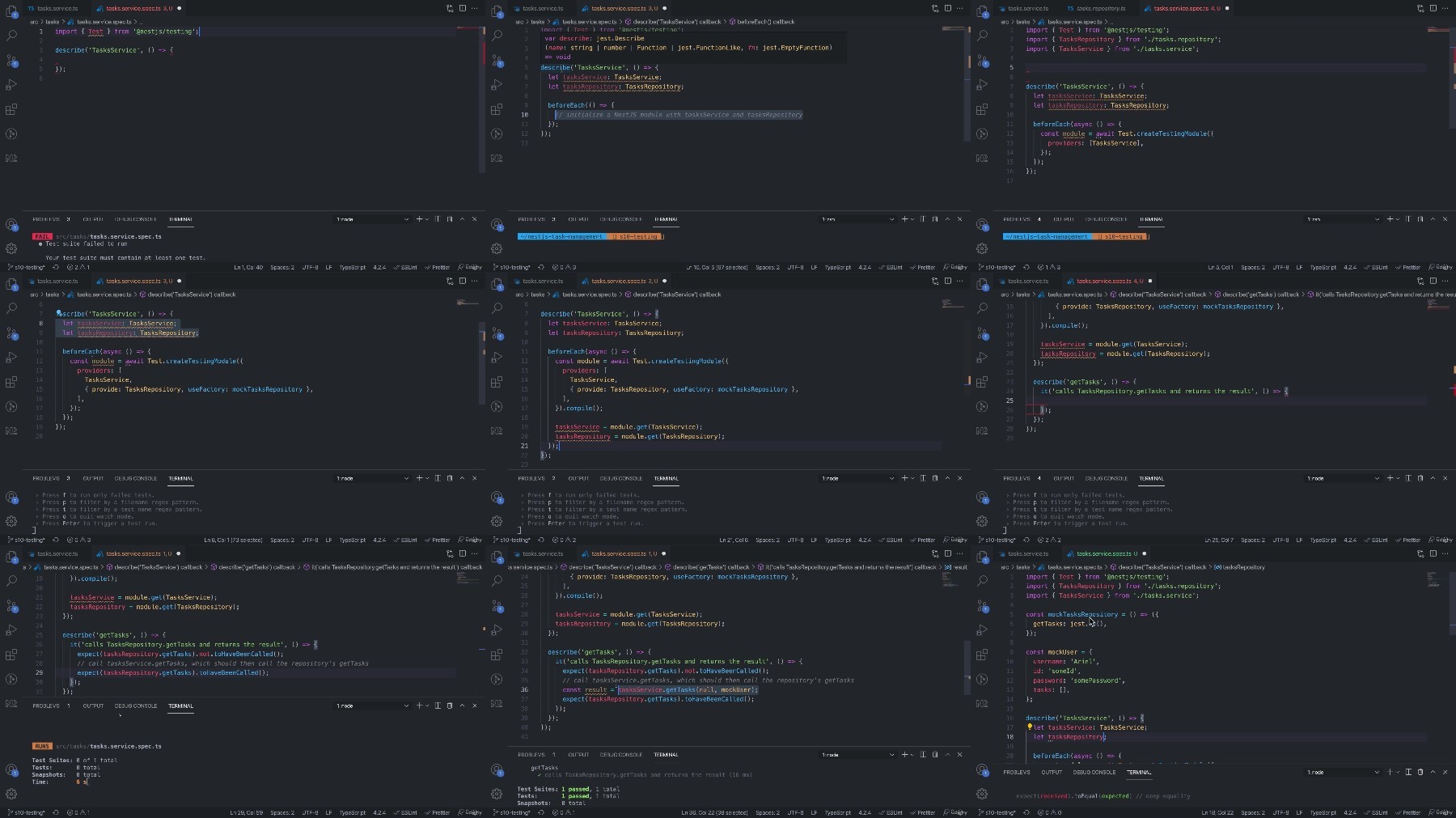- NestJS Zero to Hero - Modern TypeScript Back-end Development (Updated)

Udemy - NestJS Zero to Hero - Modern TypeScript Back-end Development (2020)
WEBRip | English | MP4 | 1280 x 720 | AVC ~891 kbps | 30 fps
AAC | 128 Kbps | 48.0 KHz | 2 channels | Subs: English (.srt) | ~8.5 hours | 3.89 GB
Genre: eLearning Video / Web Development, Node.Js, Programming
Develop and deploy enterprise back-end applications following best practices using Node.js and TypeScript
What you'll learn
Becoming familiar with the NestJS framework and its components
Designing and developing REST APIs performing CRUD operations
Authentication and Authorization for back-end applications
Using TypeORM for database interaction
Security best practices, password hashing and storing sensitive information
Persisting data using a database
Deploying back-end applications at a production-ready state to Amazon Web Services
Writing clean, maintainable code in-line with industry standards
Utilising the NestJS Command Line Interface (CLI)
Using Postman for testing back-end services
Using pgAdmin as an interface tool to manage PostgreSQL databases
Implement efficient logging in a back-end application
Environment-based configuration management and environment variables
Implementing data validation and using Pipes
Guarding endpoints for authorized users using Guards
Modelling entities for the persistence layer
TypeScript best practices
Handling asynchronous operations using async-await
Using Data Transfer Objects (DTO)
Hands-on experience JSON Web Tokens (JWT)
Unit testing NestJS applications
Using GraphQL with NestJS
Database persistence with MongoDB
Requirements
Having a basic understanding of jаvascript and/or NodeJS
Having basic knowledge of TypeScript is recommended, but not required
Description
NestJS is a Node.js back-end development framework built upon Express, leveraging the power of TypeScript.
NestJS leverages the incredible popularity and robustness of jаvascript as a language and Node.js as a technology. It is inspired by common libraries and frameworks such as Angular, React and Vue which improve developer productivity and experience.
Even considering the amount of superb libraries, helpers and tools that exist for server-side Node.js, none of them effectively solve the main problem - the architecture of an application.
NestJS provides an out-of-the-box application architecture which allows developers and teams to create highly testable, scalable, loosely coupled and easily maintainable applications.
Recently, the NestJS framework is gaining extreme popularity due to its incredible features;
Leverages TypeScript - strongly typed language which is a super-set of jаvascript
Simple to use, easy to learn and easy to master
Powerful Command Line Interface (CLI) tool that boosts productivity and ease of development
Detailed, well-maintained documentation
Active codebase development and maintenance
Open-source (MIT license)
Supports dozens nest-specific modules that help you easily integrate with common technologies and concepts such as TypeORM, Mongoose, GraphQL, Logging, Validation, Caching, Websockets and much more
Easy of unit-testing applications
Made for Monoliths and Micro-services (entire section in the documentation regarding the Microservice type of a NestJS application, as well as techniques and recipes).
In this course I am going to guide you through the process of planning, developing and deploying a fully-featured back-end application, based on my experience developing and maintaining systems that support dozens of millions of concurrent users at scale.
Who this course is for:
Intermediate jаvascript developers who want to dive into back-end development
Any developers willing to apply TypeScript on the back-end
Developers eager to learn how to develop performant, secure and production-ready REST APIs following best practices
Developers who want to learn how to deploy their application to the cloud (Amazon Web Services)
Developers who want to follow building a practical, real-world application from zero to production
also You can find my other helpful
(if old file-links don't show activity, try copy-paste them to the address bar)
General
Complete name : 4. Authorization Getting a User's Task.mp4
Format : MPEG-4
Format profile : Base Media
Codec ID : isom (isom/iso2/avc1/mp41)
File size : 21.3 MiB
Duration : 2 min 53 s
Overall bit rate : 1 027 kb/s
Writing application : Lavf58.12.100
Video
ID : 1
Format : AVC
Format/Info : Advanced Video Codec
Format profile : Main@L3.1
Format settings : CABAC / 4 Ref Frames
Format settings, CABAC : Yes
Format settings, RefFrames : 4 frames
Format settings, GOP : M=4, N=60
Codec ID : avc1
Codec ID/Info : Advanced Video Coding
Duration : 2 min 53 s
Bit rate : 891 kb/s
Nominal bit rate : 3 000 kb/s
Width : 1 280 pixels
Height : 720 pixels
Display aspect ratio : 16:9
Frame rate mode : Constant
Frame rate : 30.000 FPS
Color space : YUV
Chroma subsampling : 4:2:0
Bit depth : 8 bits
Scan type : Progressive
Bits/(Pixel*Frame) : 0.032
Stream size : 18.4 MiB (87%)
Writing library : x264 core 148
Encoding settings : cabac=1 / ref=3 / deblock=1:0:0 / analyse=0x1:0x111 / me=umh / subme=6 / psy=1 / psy_rd=1.00:0.00 / mixed_ref=1 / me_range=16 / chroma_me=1 / trellis=1 / 8x8dct=0 / cqm=0 / deadzone=21,11 / fast_pskip=1 / chroma_qp_offset=-2 / threads=22 / lookahead_threads=3 / sliced_threads=0 / nr=0 / decimate=1 / interlaced=0 / bluray_compat=0 / constrained_intra=0 / bframes=3 / b_pyramid=2 / b_adapt=1 / b_bias=0 / direct=1 / weightb=1 / open_gop=0 / weightp=2 / keyint=60 / keyint_min=6 / scenecut=0 / intra_refresh=0 / rc_lookahead=60 / rc=cbr / mbtree=1 / bitrate=3000 / ratetol=1.0 / qcomp=0.60 / qpmin=0 / qpmax=69 / qpstep=4 / vbv_maxrate=3000 / vbv_bufsize=6000 / nal_hrd=none / filler=0 / ip_ratio=1.40 / aq=1:1.00
Audio
ID : 2
Format : AAC
Format/Info : Advanced Audio Codec
Format profile : LC
Codec ID : mp4a-40-2
Duration : 2 min 53 s
Bit rate mode : Constant
Bit rate : 128 kb/s
Channel(s) : 2 channels
Channel positions : Front: L R
Sampling rate : 48.0 kHz
Frame rate : 46.875 FPS (1024 SPF)
Compression mode : Lossy
Stream size : 2.65 MiB (12%)
Default : Yes
Alternate group : 1 Screenshots
✅ Exclusive eLearning Videos ← add to bookmarks
Feel free to contact me
when links are dead or want any repost

https://ddownload.com/ojof0nmigtzu/Udemy_NestJS_Zero_to_Hero_Modern_TypeScript_Back_end_Development.part1.rar
https://ddownload.com/l6uen200hjv6/Udemy_NestJS_Zero_to_Hero_Modern_TypeScript_Back_end_Development.part2.rar
https://rapidgator.net/file/c4979d46f0f24ba15cfd748158e06880/Udemy_NestJS_Zero_to_Hero_Modern_TypeScript_Back_end_Development.part1.rar
https://rapidgator.net/file/3579fc645769f085567a74c350430b92/Udemy_NestJS_Zero_to_Hero_Modern_TypeScript_Back_end_Development.part2.rar
https://turbobit.net/ftevjufekya8/Udemy_NestJS_Zero_to_Hero_Modern_TypeScript_Back_end_Development.part1.rar.html
https://turbobit.net/9xvyjmxu7s9r/Udemy_NestJS_Zero_to_Hero_Modern_TypeScript_Back_end_Development.part2.rar.html
